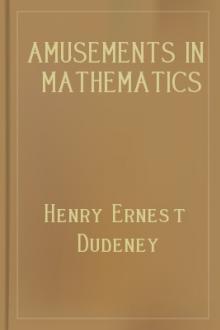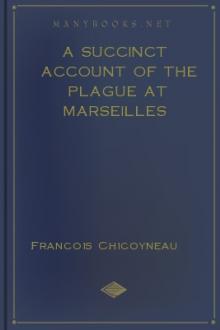Amusements in Mathematics, Henry Ernest Dudeney [books to read to be successful txt] 📗

- Author: Henry Ernest Dudeney
- Performer: 0486204731
Book online «Amusements in Mathematics, Henry Ernest Dudeney [books to read to be successful txt] 📗». Author Henry Ernest Dudeney
135.—THE STONEMASON'S PROBLEM.—solution
The puzzle amounts to this. Find the smallest square number that may be expressed as the sum of more than three consecutive cubes, the cube 1 being barred. As more than three heaps were to be supplied, this condition shuts out the otherwise smallest answer, 233 + 243 + 253 = 2042. But it admits the answer, 253 + 263 + 273 + 283 + 293 = 3152. The correct answer, however, requires more heaps, but a smaller aggregate number of blocks. Here it is: 143 + 153 + ... up to 253 inclusive, or twelve heaps in all, which, added together, make 97,344 blocks of stone that may be laid out to form a square 312 × 312. I will just remark that one key to the solution lies in what are called triangular numbers. (See pp. 13, 25, and 166.)
136.—THE SULTAN'S ARMY.—solution
The smallest primes of the form 4n + 1 are 5, 13, 17, 29, and 37, and the smallest of the form 4n - 1 are 3, 7, 11, 19, and 23. Now, primes of the first form can always be expressed as the sum of two squares, and in only one way. Thus, 5 = 4 + 1; 13 = 9 + 4; 17 = 16 + 1; 29 = 25 + 4; 37 = 36 + 1. But primes of the second form can never be expressed as the sum of two squares in any way whatever.
In order that a number may be expressed as the sum of two squares in several different ways, it is necessary that it shall be a composite number containing a certain number of primes of our first form. Thus, 5 or 13 alone can only be so expressed in one way; but 65, (5 × 13), can be expressed in two ways, 1,105, (5 × 13 × 17), in four ways, 32,045, (5 × 13 × 17 × 29), in eight ways. We thus get double as many ways for every new factor of this form that we introduce. Note, however, that I say new factor, for the repetition of factors is subject to another law. We cannot express 25, (5 × 5), in two ways, but only in one; yet 125, (5 × 5 × 5), can be given in two ways, and so can 625, (5 × 5 × 5 × 5); while if we take in yet another 5 we can express the number as the sum of two squares in three different ways.
If a prime of the second form gets into your composite number, then that number cannot be the sum of two squares. Thus 15, (3 × 5), will not work, nor will 135, (3 × 3 × 3 × 5); but if we take in an even number of 3's it will work, because these 3's will themselves form a square number, but you will only get one solution. Thus, 45, (3 × 3 × 5, or 9 × 5) = 36 + 9. Similarly, the factor 2 may always occur, or any power of 2, such as 4, 8, 16, 32; but its introduction or omission will never affect the number of your solutions, except in such a case as 50, where it doubles a square and therefore gives you the two answers, 49 + 1 and 25 + 25.
Now, directly a number is decomposed into its prime factors, it is possible to tell at a glance whether or not it can be split into two squares; and if it can be, the process of discovery in how many ways is so simple that it can be done in the head without any effort. The number I gave was 130. I at once saw that this was 2 × 5 × 13, and consequently that, as 65 can be expressed in two ways (64 + 1 and 49 + 16), 130 can also be expressed in two ways, the factor 2 not affecting the question.
The smallest number that can be expressed as the sum of two squares in twelve different ways is 160,225, and this is therefore the smallest army that would answer the Sultan's purpose. The number is composed of the factors 5 × 5 × 13 × 17 × 29, each of which is of the required form. If they were all different factors, there would be sixteen ways; but as one of the factors is repeated, there are just twelve ways. Here are the sides of the twelve pairs of squares: (400 and 15), (399 and 32), (393 and 76), (392 and 81), (384 and 113), (375 and 140), (360 and 175), (356 and 183), (337 and 216), (329 and 228), (311 and 252), (265 and 300). Square the two numbers in each pair, add them together, and their sum will in every case be 160,225.
137.—A STUDY IN THRIFT.—solution
Mrs. Sandy McAllister will have to save a tremendous sum out of her housekeeping allowance if she is to win that sixth present that her canny husband promised her. And the allowance must be a very liberal one if it is to admit of such savings. The problem required that we should find five numbers higher than 36 the units of which may be displayed so as to form a square, a triangle, two triangles, and three triangles, using the complete number in every one of the four cases.
Every triangular number is such that if we multiply it by 8 and add 1 the result is an odd square number. For example, multiply 1, 3, 6, 10, 15 respectively by 8 and add 1, and we get 9, 25, 49, 81, 121, which are the squares of the odd numbers 3, 5, 7, 9, 11. Therefore in every case where 8x2 + 1 = a square number, x2 is also a triangular. This point is dealt with in our puzzle, "The Battle of Hastings." I will now merely show again how, when the first solution is found, the others may be discovered without any difficulty. First of all, here are the figures:—
The successive pairs of numbers are found in this way:—
and so on. Look for the numbers in the table above, and the method will explain itself.
Thus we find that the numbers 36, 1225, 41616, 1413721, 48024900, and 1631432881 will form squares with sides of 6, 35, 204, 1189, 6930, and 40391; and they will also form single triangles with sides of 8, 49, 288, 1681, 9800, and 57121. These numbers may be obtained from the last column in the first table above in this way: simply divide the numbers by 2 and reject the remainder. Thus the integral halves of 17, 99, and 577 are 8, 49, and 288.
All the numbers we have found will form either two or three triangles at will. The following little diagram will show you graphically at a glance that every square number must necessarily be the sum of two triangulars, and that the side of one triangle will be the same as the side of the corresponding square, while the other will be just 1 less.

Thus a square may always be divided easily into two triangles, and the sum of two consecutive triangulars will always make a square. In numbers it is equally clear, for if we examine the first triangulars—1, 3, 6, 10, 15, 21, 28—we find that by adding all the consecutive pairs in turn we get the series of square numbers—9, 16, 25, 36, 49, etc.
The method of forming three triangles from our numbers is equally direct, and not at all a matter of trial. But I must content myself with giving actual figures, and just stating that every triangular higher than 6 will form three triangulars. I give the sides of the triangles, and readers will know from my remarks when stating the puzzle how to find from these sides the number of counters or coins in each, and so check the results if they so wish.
Square. Side of
Triangle. Sides of
Two Triangles. Sides of
Three Triangles. 36 6 8 6 + 5 5 + 5 + 3 1225 35 49 36 + 34 33 + 32 + 16 41616 204 288 204 + 203 192 + 192 + 95 1413721 1189 1681 1189 + 1188 1121 + 1120 + 560 48024900 6930 9800 6930 + 6929 6533 + 6533 + 3267 1631432881 40391 57121 40391 + 40390 38081 + 38080 + 19040
I should perhaps explain that the arrangements given in the last two columns are not the only ways of forming two and three triangles. There are others, but one set of figures will fully serve our purpose. We thus see that before Mrs. McAllister can claim her sixth £5 present she must save the respectable sum of £1,631,432,881.
138.—THE ARTILLERYMEN'S DILEMMA.—solution
We were required to find the smallest number of cannon balls that we could lay on the ground to form a perfect square, and could pile into a square pyramid. I will try to make the matter clear to the merest novice.
Here in the first row we place in regular order the natural numbers. Each number in the second row represents the sum of the numbers in the row above, from the beginning to the number just over it. Thus 1, 2, 3, 4, added together, make 10. The third row is formed in exactly the same way as the second. In the fourth row every number is formed by adding together the number just above it and the preceding number. Thus 4 and 10 make 14, 20 and 35 make 55. Now, all the numbers in the second row are triangular numbers, which means that these numbers of cannon balls may be laid out on the ground so as to form equilateral triangles. The numbers in the third row will all form our triangular pyramids, while the numbers in the fourth row will all form square pyramids.
Thus the very process of forming the above numbers shows us that every square pyramid is the sum of two triangular pyramids, one of which has the same number of balls in the side at the base, and the other one ball fewer. If we continue the above table to twenty-four places, we shall reach the number 4,900 in the fourth row. As this number is the square of 70, we can lay out the balls in a square, and can form a square pyramid with them. This manner of writing out the series until we come to a square number does not appeal to the mathematical mind, but it serves to show how the answer





Comments (0)